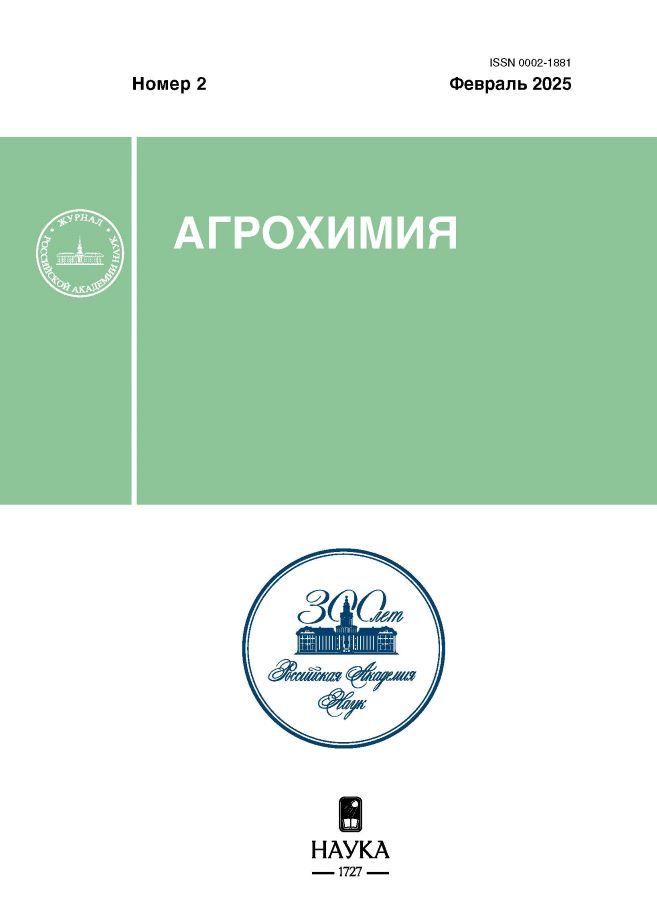Influence of long-term use of nitrogen, phosphorus and potassium fertilizers on crop yields, the balance of organic carbon and nutrients
- 作者: Vasbieva М.Т.1, Shishkov D.G.1
-
隶属关系:
- Perm Federal Scientific Center of the Ural Branch of the Russian Academy of Sciences
- 期: 编号 2 (2025)
- 页面: 16-25
- 栏目: Fertilizers
- URL: https://ruspoj.com/0002-1881/article/view/684891
- DOI: https://doi.org/10.31857/S0002188125020036
- EDN: https://elibrary.ru/vbvopm
- ID: 684891
如何引用文章
详细
The efficiency of using nitrogen, phosphorus and potash fertilizers (N90, P90, K90, N90P90, N90K90, P90K90, N90P90K90, N30P30K30, N60P60K60, N120P120K120, N150P150K150) in a long-term experiment (year of establishing– 1978, Permian Research Institute) on sod-podzolic heavy loamy soil in a field 8-pole crop rotation was evaluated. It was found that in the climatic conditions of the Urals, the use of N90 on winter rye and oats was the most effective (taking into account the payback of 1 kg of a.s. NPK with 1 kg of main products), on potatoes – (NPK)30–60, spring wheat – N60P60K60, barley – N30P30K30. There was no significant effect of mineral fertilizers on the yield of meadow clover hay of the 1st and 2nd year of use. Crop rotation productivity increased by 12–25% on average over 5 rotations when using N90, N90P90, N90K90, P90K90, and (NPK)30–150. The maximum productivity was obtained in the N60P60K60 variant – 3.31 tons of grain, the highest payback was achieved when applying nitrogen fertilizers N90 (8.9 kg of grain). At the same time, prolonged use of the mononitrogen fertilizer system led to a deterioration in soil fertility. The use of superphosphate and potassium chloride in its pure form did not significantly affect the productivity of crop rotation. The balances of organic carbon and mineral nutrition elements were calculated. A positive carbon balance was obtained using high doses of N120P120K120 and N150P150K150 (+0.06–0.13 t/ha/year), only in these variants the maintenance of the Corg content in the soil layer (0–20 cm) at the initial level was noted. The nitrogen balance, which is close to zero and positive, was formed when nitrogen fertilizers were applied at a dose of 90–150 kg a.s./ha. A positive phosphorus balance was obtained by applying superphosphate at a dose of 60 kg a.s./ha and more. A zero and positive potassium balance was formed when potassium chloride was used at a dose of 120–150 kg a.s./ha.
全文:
作者简介
М. Vasbieva
Perm Federal Scientific Center of the Ural Branch of the Russian Academy of Sciences
编辑信件的主要联系方式.
Email: vasbieva@mail.ru
Perm Research Institute of Agriculture
俄罗斯联邦, ul. Cultures 12, p. Lobanovo, Perm district, Perm region 614532D. Shishkov
Perm Federal Scientific Center of the Ural Branch of the Russian Academy of Sciences
Email: vasbieva@mail.ru
Perm Research Institute of Agriculture
俄罗斯联邦, ul. Cultures 12, p. Lobanovo, Perm district, Perm region 614532参考
- Чуян О.Г., Глазунов Г.П., Караулова Л.Н., Митрохина О.А., Афонченко Н.В., Золотухин А.Н., Двойных В.В. Оценка роли климатических, почвенных и агротехнических факторов в формировании ресурсов продуктивности агроландшафтов Центрального Черноземья // Метеорол. и гидрол. 2022. № 6. С. 79–87. doi: 10.52002/0130-2906-2022-6-79-87
- Лукин С.М., Золкина Е.И., Марчук Е.В. Влияние длительного применения удобрений на продуктивность севооборота, содержание и качественный состав органического вещества почвы // Плодородие. 2021. № 3(120). С. 93–98. doi: 10.25680/S19948603.2021.120.18
- Окорков В.В., Щукин И.М., Окоркова Л.А., Щукина В.И., Козлов А.А. Изменение содержания подвижных форм азота в серых лесных почвах ополья под влиянием ландшафтных особенностей агротехнологий // Агрохимия. 2023. № 1. С. 13–24. doi: 10.31857/S0002188123010088
- Сычев В.Г., Шафран С.А., Виноградова С.Б. Плодородие почв России и пути его регулирования // Агрохимия. 2020. № 6. С. 3–13. doi: 10.31857/S0002188120060125
- Постников П.А., Попова В.В., Данько Е.Ф., Васина О.В. Урожайность культур, вынос и баланс элементов питания в зернотравяном севообороте // Плодородие. 2022. № 3(126). С. 16–19. doi: 10.25680/S19948603.2022.126.04
- Сычев В.Г. Основные ресурсы урожайности сельскохозяйственных культур и их взаимосвязь. М.: ЦИНАО, 2003. 228 с.
- Агроклиматические ресурсы Пермской области / Под ред. Е.В. Григорчук. Л.: Гидрометеоиздат, 1979. 156 c.
- Еремченко О.З., Шестаков И.Е., Москвина Н.В. Почвы и техногенные поверхностные образования урбанизированных территорий Пермского Прикамья. Пермь: Перм. гос. нац. исслед. ун-т., 2016. 252 с.
- Мерзлая Г.Е. Исследование устойчивости агроценозов при длительном применении удобрений на дерново-подзолистой почве // Почвоведение. 2021. № 3. С. 355–362. doi: 10.31857/S0032180X21030126
- Vasbieva M.T., Zavyalova N.E., Shishkov D.G. Changes in the agrochemical properties of albic retisol (Abruptic, Aric, Loamic) during a long-term use of nitrogen, phosphorus, and potassium fertilizers under Cis-Ural // Eur. Soil Sci. 2022. V. 55. № 11. P. 1623–1632. doi: 10.1134/S1064229322110138
- Иванов А.И., Иванова Ж.А., Воробьев В.А., Цыганова Н.А. Агроэкологические последствия длительного применения дефицитных систем удобрения на хорошо окультуренных дерново-подзолистых почвах // Агрохимия. 2016. № 4. С. 10–17.
- Лапа В.В., Кулеш О.Г. Роль уровня почвенной кислотности и условий питания в изменении агрохимических свойств дерново-подзолистой легкосуглинистой почвы // Почвовед. и агрохим. 2015. № 1(54). С. 140–150.
- Гамзиков Г.П. Состояние и перспективы исследований в длительных стационарных опытах с удоб- рениями в Сибири // Плодородие. 2016. № 5(92). С. 6–9.
- Лукин С.М., Мерзлая Г.Е. Сравнительная эффективность различных систем удобрения при длительном их применении в севооборотах // Плодородие. 2016. № 5(92). С. 42–47.
- Завьялова Н.Е., Васбиева М.Т., Шишков Д.Г., Казакова И.В. Агрохимические показатели, содержание и запасы подвижных и необменных форм калия в профиле пахотной дерново-подзолистой почвы длительного опыта при внесении возрастающих доз NPK // Рос. сел.-хоз. наука. 2022. № 5. С. 54–59. doi: 10.31857/S2500262722050106
- Плотников А.М., Кабдунова Г.С. Баланс элементов питания и продуктивность зернопарового севооборота при применении минеральных удобрений // Пробл. агрохим. и экол. 2018. № 1. С. 38–41.
- Дзюин Г.П., Дзюин А.Г. Коэффициенты использования азота, фосфора и калия из минеральных удобрений, навоза и почвы культурами севооборота // Международ. журн. эксп. образ-я. 2016. № 5(Ч. 1). С. 83–90.
- Дуйшембиев Н.Д., Ахматбеков М.А., Мамбетов К.Б., Жайнакова Г.Б., Эмил У.У. Коэффициенты использования элементов питания растениями в севообороте, при длительном применении удобрений // Вестн. Кыргыз. нац. аграрн. ун-та им. К.И. Скрябина. 2018. № 2(47). С. 51–58.
补充文件









